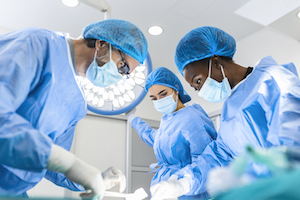Having Surgery With Diabetes
By Jewels Doskicz
 Having a surgical procedure, whether it's planned or an emergency, comes with added risks when you have diabetes. Learn more about preparing for surgery with diabetes, how to advocate for your needs, why in-range glucose values are important, and how to minimize your risks.
Having a surgical procedure, whether it's planned or an emergency, comes with added risks when you have diabetes. Learn more about preparing for surgery with diabetes, how to advocate for your needs, why in-range glucose values are important, and how to minimize your risks.
When Caitlyn Peterson of Flagstaff, Arizona – an English as a Second Language educator who has lived with type 1 diabetes (T1D) for 25 years – recently needed emergency surgery for a fractured ankle, she was more worried about her diabetes in the hospital than the surgery. Being knowledgeable about her own care, she made sure to communicate everything about her diabetes needs to the medical team before the surgery.
Peterson was most worried about experiencing hypoglycemia (low blood glucose) while under anesthesia in the operating room. When she voiced her concerns and her anesthesia provider explained their management plan, she began to relax about the surgery. But the experience itself, whether planned or unplanned, is different for each person, and there are things to be aware of, especially for a person with diabetes.
Self-advocacy
Over 37 million Americans live with diabetes (about 11% of the population), and many will require surgery in their lifetime. And whether someone has T1D or type 2 diabetes (T2D), communication is an important part of the surgical experience. Advocating for yourself or a loved one is an important part of living with a chronic condition, because when others make decisions without your input – there may be assumptions and actions that don’t fully fit your needs.
Familiar forms of self-advocacy include:
-
Educating others about your health condition.
-
Teaching others about the medical technology you use and how it works.
-
Communicating about questions or concerns related to your individual situation.
-
Understanding your rights as a person with diabetes.
Preparing for surgery with diabetes
Although diabetes awareness is growing, not all providers have frequent exposure to diabetes technology, such as continuous glucose monitors (CGM) and insulin pumps, along with the specific protocols that need to be taken into account.
“I’m continuously educating others about T1D – even in the case of surgery,” said Peterson. “We can’t assume that providers know what’s best for us as individuals.”
Dr. Michelle Grua, an anesthesia provider at Valley Children’s in Fresno, California, with 28 years of adult and pediatric experience, said that people with diabetes should advocate for the use of their own technology during their hospital stay. “This can happen by being proactive and educating the anesthesia provider about your management,” she said. When using an insulin pump, removing it will stop the delivery of your basal insulin and increase your risk of diabetic ketoacidosis (DKA) if you're not started on an IV insulin drip or receive a basal insulin injection.
Grua added that while anesthesia providers are very careful in measuring blood sugars throughout the phases of surgery, you should not hesitate to ask questions.
Here’s a few to get started:
-
What type of anesthesia will I be receiving and do I have any options (general, nerve block, IV sedation, or local anesthesia)?
-
At what intervals will my blood glucose be measured during the procedure?
-
Can I keep my insulin pump and continuous glucose monitor (CGM) on in the operating room?
-
Does the hospital have a protocol for insulin management throughout surgery?
-
How will my blood sugar be managed during surgery and after surgery in the recovery room?
-
Do you have any questions about how my CGM and pump work?
Emergency vs. Scheduled procedures
While some procedures may allow time for planning, others may not. “Unplanned surgery can be more anxiety provoking when you don’t have the time to think things through,” said Peterson.
If you’re in an accident, or have a sudden illness that needs immediate surgery, there’s not much time for forward thinking. Here are some precautions you can take to be prepared in case of an emergency.
-
If possible, have a friend or family member gather your medical supplies (glucometer, CGM, pump supplies, insulin) – if your infusion site or CGM is in the way of the surgical procedure, it may need removal.
-
Have a list of your current medications, supplements, and any allergies in your phone or wallet. If you wear an insulin pump, know your total daily dose of basal insulin in case you need to remove your pump and receive an injection.
-
It also helps to know your insulin to carb ratio and your correction factor. This will help the health care team dose meal time and correction insulin.
-
Have a healthcare proxy. This is a legal document that allows you to designate a care partner to make your care decisions in the event that you are incapacitated. Ensure that this trusted individual has ready access to the document.
Preoperative instructions
Your surgeon and care team will give you specific instructions in advance of the procedure. If you don’t agree with the instructions, or are uncertain about your diabetes plan, ask your endocrinologist or primary care provider for support. It’s never too early to reach out for clarification.
Before surgery, know:
-
How to make necessary adjustments to your diabetes medications
-
When to stop eating and drinking
-
What to do if you experience low glucose levels during your fasting period
-
Who to contact with concerns as surgery approaches
-
How your glucose will be monitored and managed in the operating room
Why can’t you eat and drink before a procedure?
When a person has to be on anesthesia, it affects the body’s reflexes. With the body’s muscles relaxed, anything in the stomach can come back up and enter the lungs.
For a planned surgery, ask to be scheduled as the first-case of the day if possible. This can help to shorten the waiting period of not eating and decrease the chances of low glucose during the fasting period or during the surgery.
Surgery with type 2 diabetes
Although some people with T2D may take insulin, many do not. Oral and non-insulin injectable medications are common, each of which may have special precautions or need adjustments before surgery.
“There are different reasons for not taking oral diabetes medications,” Grua said. “But most are stopped before surgery, and patients are aware that if they take them within 24 hours of their surgery, it may be canceled.” Certain medications can cause issues during a procedure, so share an accurate medication list before any procedure. For instance, metformin can cause kidney issues and other medical concerns during surgery, while sulfonylureas can increase insulin production and can cause hypoglycemia when fasting. Additionally, it is recommended that people on a SGLT-2 inhibitor stop their medication at least 3 days prior to the surgery.
Reduce Surgical Risks
Keeping your blood glucose values in range before, during, and after surgery can help decrease your risk for infection and other complications. Researchers have shown that high blood glucose values are associated with delayed healing and increased infection rates. Blood glucose and A1C values are measured before the operation.
“Knowing what these goal values are will help you to be prepared and approved for surgery. If not, surgery may be canceled — even on the day of,” Grua added. “Whether you have type 1 or type 2 diabetes, having the best possible A1C, and arriving for surgery with a blood glucose level less than 200, is the goal. The value that’s most likely to lead to a surgery cancellation is a blood glucose that’s 250 or higher on the day of surgery.”
Having a surgical procedure may increase blood glucose levels because of emotional stress, anesthesia, and the trauma of the surgery itself. And while everyone has a risk of infection, research suggests that people with diabetes may be at higher risk of:
-
Slower healing
-
Increased infection rates at the surgical site
-
Secondary infections, such as a urinary tract infection or pneumonia
-
Increased variability of blood glucose
Be on the Lookout for Signs and Symptoms of Infection
Once surgery is complete, it’s especially important to keep your eye out for any signs or symptoms of infection. Be sure to contact your healthcare team about any questions or concerns you may have.
Signs and symptoms of infection may include:
-
Fever or chills.
-
Increased pain, redness, or tenderness around the surgical area.
-
Pus or smelly drainage from the surgical site.








